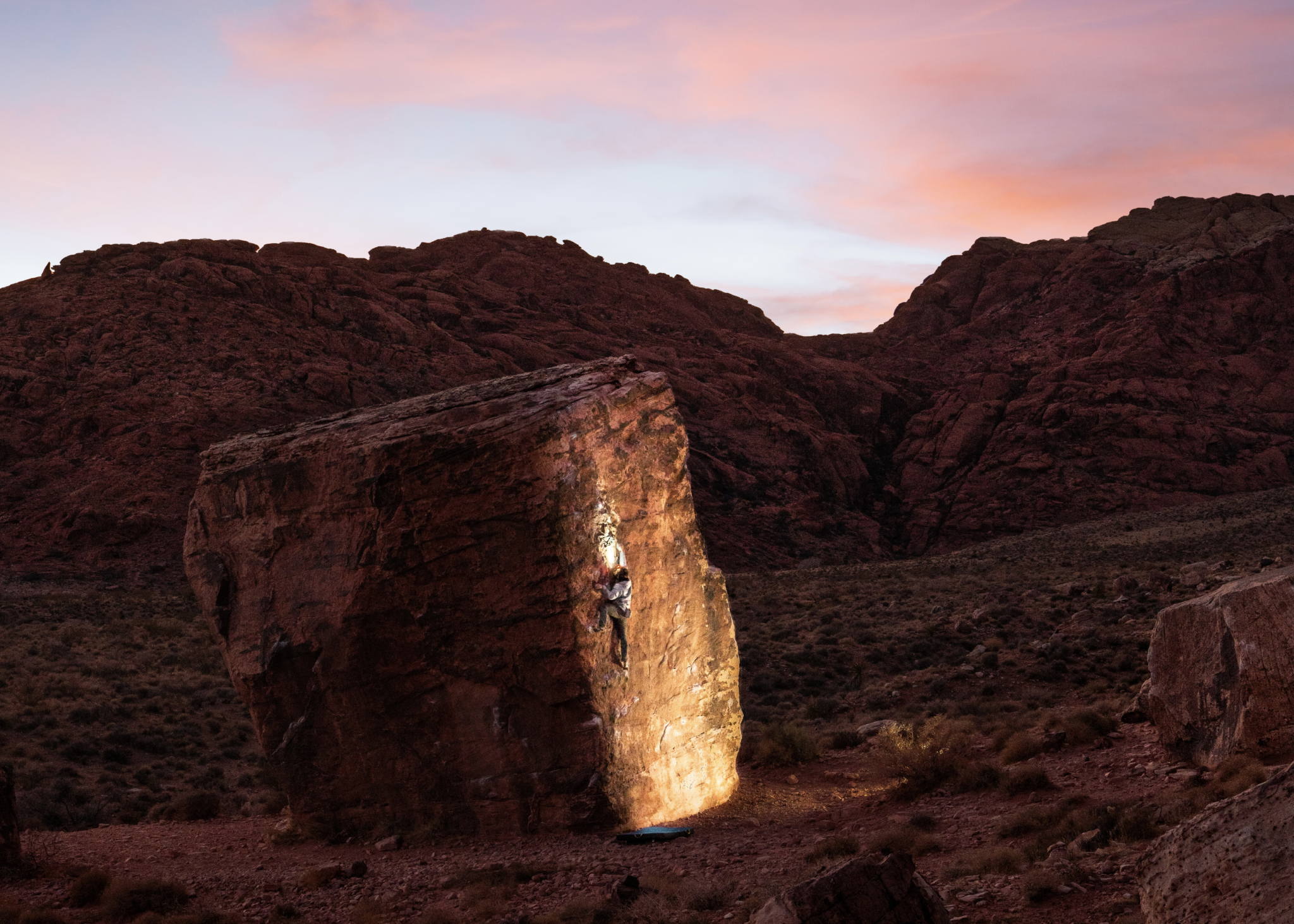Calico Basin Recreation Area in Red Rock National Conservation Area (Red Rock) provides hundreds of easy-to-access, high-quality rock climbing opportunities. From trad test pieces to five-star sport climbing to the sprawling Kraft boulder field, it offers something special for almost every kind of climber.
Bouldering in Calico Basin, Red Rock Canyon, Las Vegas, Nevada. Ancestral lands of Southern Paiute and Western Shoshone. © Al Baker
But it’s not just special to climbers. People from all walks of life visit this conservation area for its scenic and ecological beauty. Thanks to its free and open access, you might see wedding parties, horseback riders, hikers, picnickers, and climbers all sharing the same space on any given weekend. It’s exactly this diversity that makes Calico Basin so special—and what it stands to lose if the latest management proposal by the Bureau of Land Management (BLM) goes into effect.
The Bureau of Land Management is charged with protecting and conserving Red Rock for the American public, including Calico Basin, and BLM has been looking at strategies to address the steady increase in visitors over the last decade. Access Fund and Southern Nevada Climbers Coalition (SNCC) have been deeply engaged in this planning process, and in May of this year, BLM released the final Calico Basin Recreation Area Management Plan.
In the final plan, the BLM has decided to add a gate, impose an entry fee, restrict hours, and implement a reservation system in order to limit and control the number of people who can access Calico Basin. Its hope is that this will address impacts to natural resources and raise revenue. The BLM neglected to seriously consider other management alternatives before issuing a final decision—a concerning move under the National Environmental Policy Act (NEPA).
Access Fund and SNCC believe that restrictive management approaches—like gates, fees, reservations, etc.—should only be implemented after other options have been exhausted. Land managers must try to address identified impacts through proven strategies like visitor education, parking enforcement, additional on-site staff, and other adaptive management tactics before moving ahead with restrictions. Further, any restrictive management tactic should be looked at individually and considered in conjunction with adaptive management strategies—a modest fee along with better enforcement and visitor education may achieve the same outcome without having to build a gate or implement a reservation system. Calico Basin has always been free of locked gates and open 24/7. The BLM never considered any of these other alternatives, which is generally required by the NEPA process.
These kinds of management decisions can have unintended consequences. Access Fund and SNCC are also concerned that a fee will price out people in our community who can’t afford to pay to enjoy public lands. Along with a gate, this management approach could send a very unwelcoming message, which could have a disproportionate impact on marginalized communities and their ability to enjoy this very special place.
Access Fund and SNCC are also concerned that the BLM will just be pushing the problem elsewhere. Recent access limitations in the nearby Red Rock Canyon Scenic Loop are at least partially responsible for the dramatic uptick in Calico Basin visitation in the last year, and if similar limitations are used in Calico Basin, it’s only going to move the problem down the road rather than solve it. BLM also ignored this important issue.
Because of these shortcomings, Access Fund and Southern Nevada Climbers Coalition have filed a Notice of Administrative Appeal to further engage with the BLM in finding better solutions to managing visitor use beyond installing a gate and restricting access. As climbers, we all care deeply for the environment and the special places we enjoy. But we firmly believe education, partnerships, staffing, and adaptive management should at least be considered as alternatives to address the situation before deciding to build a gate and require reservations. Access Fund, SNCC, and many climbers are ready, willing, and able to assist BLM with these other management strategies to find a sustainable solution.
Our suggestions to the BLM are:
The BLM must consider less restrictive management alternatives that will preserve sustainable and equitable access to Calico Basin.
The BLM should implement and iterate adaptive management strategies that use data and feedback to evaluate effectiveness—e.g., visitor education, parking enforcement and fees, and increased ranger presence.
The BLM should consider the indirect and cumulative impacts that may result from restrictions on access at Calico Basin and the Scenic Loop on other areas of Red Rock and surrounding public lands, and it should look at comprehensive recreation management strategies.
The BLM should deepen its partnerships with nonprofit organizations that are ready and willing to help educate climbers and visitors, maintain trails, promote stewardship, manage impacts, and preserve natural resources.
The BLM should commit to investing any additional fees into recreational infrastructure, visitor education, and basic visitor amenities.
If the BLM must move forward with the proposed gate, it should allow for early entry/late exit, similar to the Scenic Loop, along with allowances for pedestrians to enter without paying a fee.
Access Fund will keep the climbing community up to date as the appeal moves forward. If you have any questions about the process or the plan, check out these answers to some frequently asked questions.


